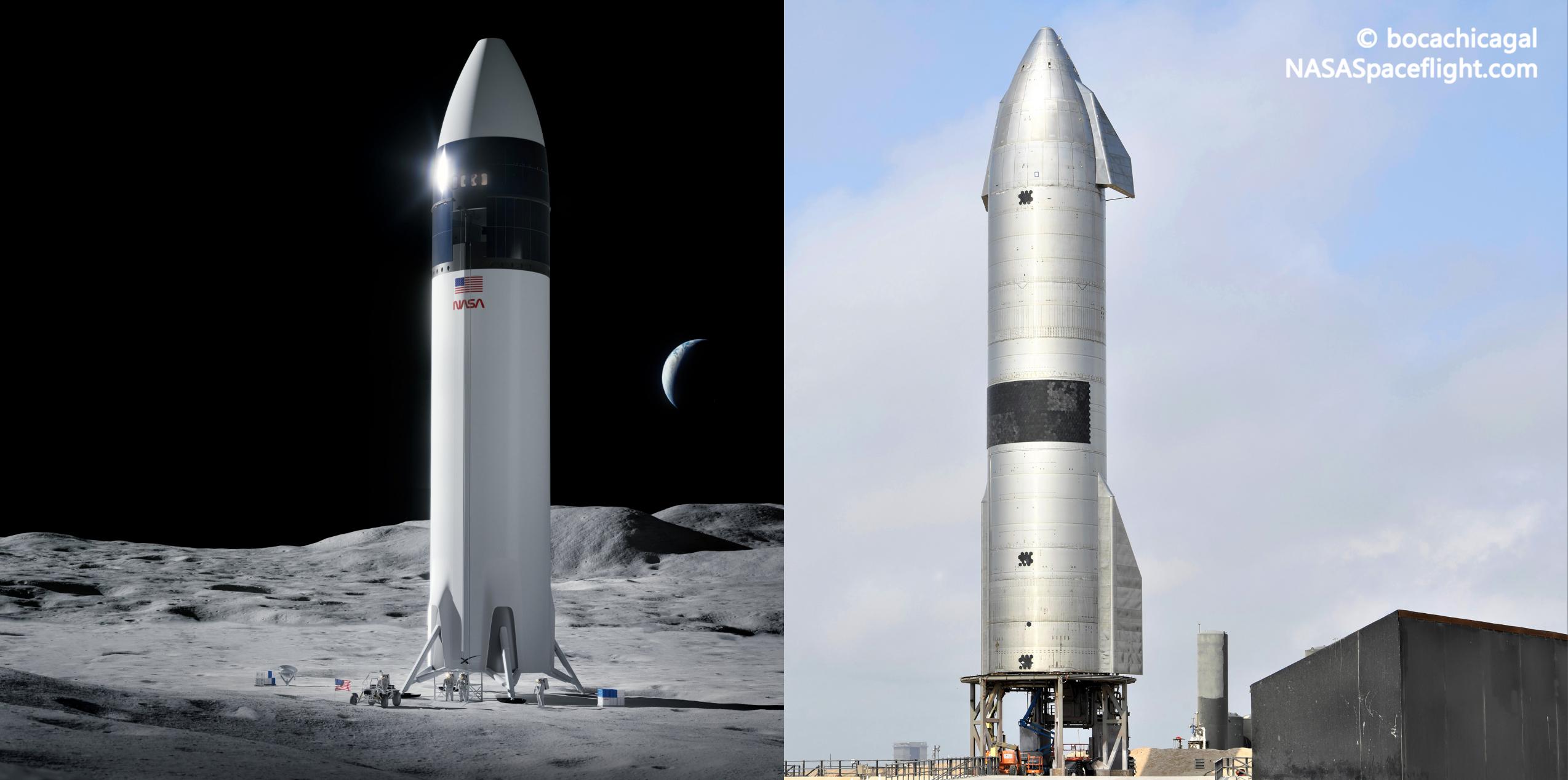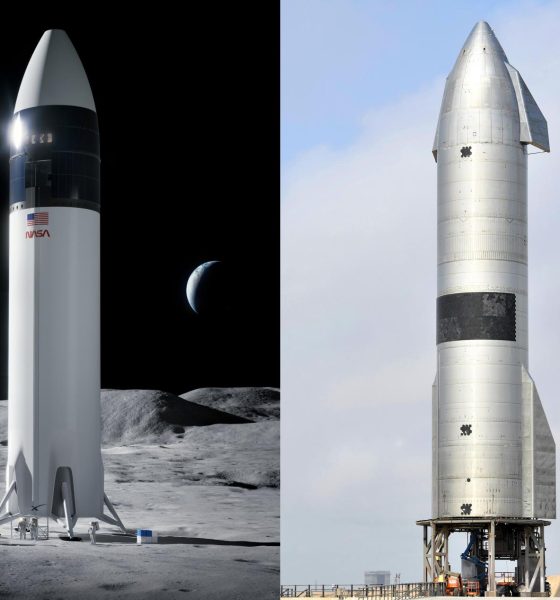

News
SpaceX’s NASA Starship contract safe for now as Blue Origin looks to Congress
Fresh off of a major contract loss during a competition to build NASA’s next crewed Moon lander, Blue Origin has begun aggressively lobbying Congress for the contract NASA didn’t give it.
Thankfully, albeit not at first, a modification has been made to an amendment first proposed by a Senator that has long pursued favorable treatment of Blue Origin that will prevent that legislation – if it passes – from unfairly interrupting the $2.9 billion contract NASA already awarded SpaceX. Announced on April 16th, that award came as a shock, effectively cementing SpaceX’s lunar Starship as both the cheapest and most technically sound proposal to return humanity to the Moon.
As such, although NASA made it clear that it would have selected two of the three competing proposals in a perfect scenario, Congress allocated just a quarter of the Human Landing System (HLS) funding NASA requested, forcing the agency between a rock and a hard place.
NASA repeatedly stated as much both before and after the decision was announced, effectively implying that the agency had learned its lesson with the Commercial Crew Program, in which it had selected two redundant providers – Boeing and SpaceX – only for Congress to systematically underfund the program for years. As a direct result of years of underfunding during an early and formative period, both providers suffered at least 2-3 years of delays, followed by another few years of more organic delays as development matured and new challenges were unsurprisingly uncovered.
Politically, NASA could never say that – effectively biting the hand that (under)feeds – out loud, but it was strongly implied in an official HLS source selection statement released to partially explain why it had chosen SpaceX and SpaceX alone. Almost instantly, both losing competitors – Blue Origin and Dynetics – filed protests with the US Government Accountability Office (GAO) filled with far more bizarre, rambling tangents than coherent legal arguments.
Unless GAO operates on a different standard than the court of law or uncovers something nefarious behind closed doors, a close reading of both partially redacted protests does not bode well for either document’s ability to sway the office’s opinion. Almost as if Blue Origin itself is aware of just how frivolous its protest really is, the company – seemingly backed by partners Northrop Grumman, Lockheed Martin, and Leidos – wasted no time lobbying Senator Maria Cantwell for an alternate avenue to get what it wants and the government money founder Jeff Bezos feels entitled to.
Cantwell represents Washington State, where both Amazon and Blue Origin are headquartered, and has frequently spoken out in support of – or personally introduced – legislation that would specifically favor Bezos’ space company. On May 12th, Cantwell introduced an amendment that would purportedly “maintain competitiveness” by forcing NASA to select a second HLS winner in addition to SpaceX. Without irony, the authorization bill also demanded that NASA make that decision within a mere 30 days.
Under those conditions, Congress would authorize $10 billion for NASA to develop and demonstrate two landers with an uncrewed and crewed Moon landing each – the original plan. Insultingly, Cantwell tacked that amendment onto an authorization bill, meaning that even if Congress were to pass the bill and the President were to sign it into law, Congress would still have to actually allocate that $10 billion in the form of a more than 10% boost to NASA’s annual budget. Historically, even if Congress were to defy all recent precedent and significantly boost NASA’s 2022 budget, there is no guarantee that that raise would be upheld for four or more years, which it would need to be for the authorization bill to be anything more than a hollow promise.
More recently, a clause was thankfully added clarifying that NASA is not allowed to “modify, terminate, or rescind” SpaceX’s HLS contract to comply with the amendment. Additionally, while still amounting to a legal gun to NASA’s head to force it to into a contract it knows it cant afford, the modification gives NASA 60 days to award a second lander contract. Based on the agency’s own selection statement, Blue Origin’s National Team would almost certainly be the recipient in the event that the bill becomes law, forcing NASA to commit more than $9 billion – instead of $2.9 billion – to the next stage of HLS development with no guarantee that its budget will be raised accordingly.
In the meantime, GAO still has to complete its reviews of Blue Origin and Dynetic’s protests and the White House has to submit its FY2022 budget request and consider adding NASA funding to its proposed jobs and infrastructure package.

Elon Musk
Tesla AI Head says future FSD feature has already partially shipped

Tesla’s Head of AI, Ashok Elluswamy, says that something that was expected with version 14.3 of the company’s Full Self-Driving platform has already partially shipped with the current build of version 14.2.
Tesla and CEO Elon Musk have teased on several occasions that reasoning will be a big piece of future Full Self-Driving builds, helping bring forth the “sentient” narrative that the company has pushed for these more advanced FSD versions.
Back in October on the Q3 Earnings Call, Musk said:
“With reasoning, it’s literally going to think about which parking spot to pick. It’ll drop you off at the entrance of the store, then go find a parking spot. It’s going to spot empty spots much better than a human. It’s going to use reasoning to solve things.”
Musk said in the same month:
“By v14.3, your car will feel like it is sentient.”
Amazingly, Tesla Full Self-Driving v14.2.2.2, which is the most recent iteration released, is very close to this sentient feeling. However, there are more things that need to be improved, and logic appears to be in the future plans to help with decision-making in general, alongside other refinements and features.
On Thursday evening, Elluswamy revealed that some of the reasoning features have already been rolled out, confirming that it has been added to navigation route changes during construction, as well as with parking options.
He added that “more and more reasoning will ship in Q1.”
🚨 Tesla’s Ashok Elluswamy reveals Nav decisions when encountering construction and parking options contain “some elements of reasoning”
More uses of reasoning will be shipped later this quarter, a big tidbit of info as we wait v14.3 https://t.co/jty8llgsKM
— TESLARATI (@Teslarati) January 9, 2026
Interestingly, parking improvements were hinted at being added in the initial rollout of v14.2 several months ago. These had not rolled out to vehicles quite yet, as they were listed under the future improvements portion of the release notes, but it appears things have already started to make their way to cars in a limited fashion.
Tesla Full Self-Driving v14.2 – Full Review, the Good and the Bad
As reasoning is more involved in more of the Full Self-Driving suite, it is likely we will see cars make better decisions in terms of routing and navigation, which is a big complaint of many owners (including me).
Additionally, the operation as a whole should be smoother and more comfortable to owners, which is hard to believe considering how good it is already. Nevertheless, there are absolutely improvements that need to be made before Tesla can introduce completely unsupervised FSD.
Elon Musk
Tesla’s Elon Musk: 10 billion miles needed for safe Unsupervised FSD
As per the CEO, roughly 10 billion miles of training data are required due to reality’s “super long tail of complexity.”

Tesla CEO Elon Musk has provided an updated estimate for the training data needed to achieve truly safe unsupervised Full Self-Driving (FSD).
As per the CEO, roughly 10 billion miles of training data are required due to reality’s “super long tail of complexity.”
10 billion miles of training data
Musk comment came as a reply to Apple and Rivian alum Paul Beisel, who posted an analysis on X about the gap between tech demonstrations and real-world products. In his post, Beisel highlighted Tesla’s data-driven lead in autonomy, and he also argued that it would not be easy for rivals to become a legitimate competitor to FSD quickly.
“The notion that someone can ‘catch up’ to this problem primarily through simulation and limited on-road exposure strikes me as deeply naive. This is not a demo problem. It is a scale, data, and iteration problem— and Tesla is already far, far down that road while others are just getting started,” Beisel wrote.
Musk responded to Beisel’s post, stating that “Roughly 10 billion miles of training data is needed to achieve safe unsupervised self-driving. Reality has a super long tail of complexity.” This is quite interesting considering that in his Master Plan Part Deux, Elon Musk estimated that worldwide regulatory approval for autonomous driving would require around 6 billion miles.
FSD’s total training miles
As 2025 came to a close, Tesla community members observed that FSD was already nearing 7 billion miles driven, with over 2.5 billion miles being from inner city roads. The 7-billion-mile mark was passed just a few days later. This suggests that Tesla is likely the company today with the most training data for its autonomous driving program.
The difficulties of achieving autonomy were referenced by Elon Musk recently, when he commented on Nvidia’s Alpamayo program. As per Musk, “they will find that it’s easy to get to 99% and then super hard to solve the long tail of the distribution.” These sentiments were echoed by Tesla VP for AI software Ashok Elluswamy, who also noted on X that “the long tail is sooo long, that most people can’t grasp it.”
News
Tesla earns top honors at MotorTrend’s SDV Innovator Awards
MotorTrend’s SDV Awards were presented during CES 2026 in Las Vegas.

Tesla emerged as one of the most recognized automakers at MotorTrend’s 2026 Software-Defined Vehicle (SDV) Innovator Awards.
As could be seen in a press release from the publication, two key Tesla employees were honored for their work on AI, autonomy, and vehicle software. MotorTrend’s SDV Awards were presented during CES 2026 in Las Vegas.
Tesla leaders and engineers recognized
The fourth annual SDV Innovator Awards celebrate pioneers and experts who are pushing the automotive industry deeper into software-driven development. Among the most notable honorees for this year was Ashok Elluswamy, Tesla’s Vice President of AI Software, who received a Pioneer Award for his role in advancing artificial intelligence and autonomy across the company’s vehicle lineup.
Tesla also secured recognition in the Expert category, with Lawson Fulton, a staff Autopilot machine learning engineer, honored for his contributions to Tesla’s driver-assistance and autonomous systems.
Tesla’s software-first strategy
While automakers like General Motors, Ford, and Rivian also received recognition, Tesla’s multiple awards stood out given the company’s outsized role in popularizing software-defined vehicles over the past decade. From frequent OTA updates to its data-driven approach to autonomy, Tesla has consistently treated vehicles as evolving software platforms rather than static products.
This has made Tesla’s vehicles very unique in their respective sectors, as they are arguably the only cars that objectively get better over time. This is especially true for vehicles that are loaded with the company’s Full Self-Driving system, which are getting progressively more intelligent and autonomous over time. The majority of Tesla’s updates to its vehicles are free as well, which is very much appreciated by customers worldwide.








